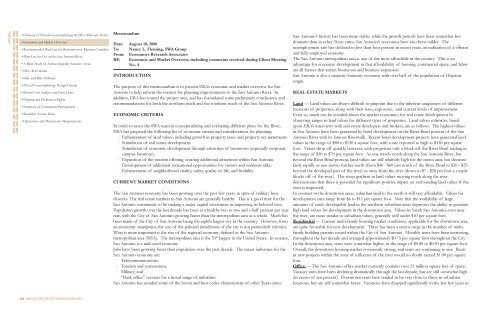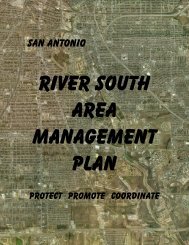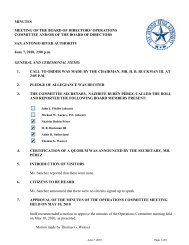concept design san antonio river improvements project
concept design san antonio river improvements project
concept design san antonio river improvements project
Create successful ePaper yourself
Turn your PDF publications into a flip-book with our unique Google optimized e-Paper software.
APPENDIX<br />
• Glossary of Fluvial Geomorphologic & Other Relevant Terms<br />
• Economic and Market Overview<br />
• Recommended Plant List for Restoration of Riparian Corridors<br />
• Plant List for Use on the San Antonio River<br />
• A Brief Study of Archaeologically Sensitive Areas<br />
• HEC-RAS Model<br />
• Hike and Bike Pathways<br />
• Fluvial Geomorphology Design Criteria<br />
• Master Cost Analysis and Gant Chart<br />
• Naming and Dedication Rights<br />
• Summary of Community Participation<br />
• Brooklyn Avenue Dam<br />
• Operations and Maintenance Requirements<br />
104 SAN ANTONIO RIVER DESIGN GUIDELINES<br />
Memorandum<br />
Date: August 10, 2000<br />
To: Nancy L. Fleming, SWA Group<br />
From: Economics Research Associates<br />
RE: Economic and Market Overview, including comments received during Client Meeting<br />
No. 4<br />
INTRODUCTION<br />
The purpose of this memorandum is to present ERA’s economic and market overview for San<br />
Antonio to help inform the context for planning <strong>improvements</strong> to the San Antonio River. In<br />
addition, ERA has toured the <strong>project</strong> area, and has formulated some preliminary conclusions and<br />
recommendations for both the northern reach and the southern reach of the San Antonio River.<br />
ECONOMIC CRITERIA<br />
In order to assist the SWA team in <strong>concept</strong>ualizing and evaluating different plans for the River,<br />
ERA has prepared the following list of economic criteria and considerations for planning:<br />
· Enhancement of land values, including growth in property taxes and property tax increments.<br />
· Stimulation of real estate development.<br />
· Stimulation of economic development through attraction of businesses (especially corporate<br />
campus locations).<br />
· Expansion of the tourism offering, creating additional attractions within San Antonio.<br />
· Development of additional recreational opportunities for visitors and residents alike.<br />
· Enhancement of neighborhood vitality, safety, quality of life, and livability.<br />
CURRENT MARKET CONDITIONS<br />
The San Antonio economy has been growing over the past few years, in spite of military base<br />
closures. The real estate markets in San Antonio are generally healthy. This is a good time for the<br />
San Antonio community to be making a major capital investment in improving its beloved <strong>river</strong>.<br />
Population growth over the last decade has been at a healthy two to two and a half percent per year<br />
rate, with the City of San Antonio growing faster than the metropolitan area as a whole. Much has<br />
been made of the City of San Antonio being the eighth largest city in the country. However, from<br />
an economic standpoint, the size of the political jurisdiction of the city is not particularly relevant.<br />
What is more important is the size of the regional economy, defined as the San Antonio<br />
metropolitan area (MSA). The metropolitan area is the 35 th largest in the United States. In essence,<br />
San Antonio is a mid-sized economy.<br />
Jobs have been growing faster than population over the past decade. The major industries for the<br />
San Antonio economy are:<br />
· Telecommunications,<br />
· Tourism and conventions,<br />
· Military, and<br />
· “Back office” services for a broad range of industries.<br />
San Antonio has avoided some of the boom and bust cycles characteristic of other Texas cities.<br />
San Antonio’s history has been more stable; while the growth periods have been somewhat less<br />
dramatic than in other Texas cities, San Antonio’s recessions have also been milder. The<br />
unemployment rate has declined to less than four percent in recent years, an indication of a vibrant<br />
and fully employed economy.<br />
The San Antonio metropolitan area is one of the most affordable in the country. This is an<br />
advantage for economic development in that affordability of housing, commercial space, and labor<br />
are all factors that attract businesses and business expansion.<br />
San Antonio is also a majority/minority economy with over half of the population of Hispanic<br />
origin.<br />
REAL ESTATE MARKETS<br />
Land — Land values are always difficult to pinpoint due to the inherent uniqueness of different<br />
locations of properties, along with their sizes, exposures, and current levels of improvement.<br />
Even so, much can be revealed about the market economics for real estate development by<br />
observing ranges in land values for different types of properties. Land values estimates, based<br />
upon ERA’s interviews with real estate developers and brokers, are as follows. The highest values<br />
in San Antonio have been generated by hotel development on the River Bend portion of the San<br />
Antonio River with its famous Riverwalk. Recent hotel development <strong>project</strong>s have generated land<br />
values in the range of $80 to $120 a square foot, with some reported as high as $150 per square<br />
foot. Values drop off quickly, however, with properties only a block off the River Bend trading in<br />
the range of $50 to $70 per square foot. As one travels north along the San Antonio River, but<br />
beyond the River Bend portion, land values are still relatively high for the metro area, but decrease<br />
fairly rapidly as one moves further north (from $40 - $60 just north of the River Bend to $20 - $25<br />
beyond the developed part of the <strong>river</strong>) or away from the <strong>river</strong> (down to $7 - $20 per foot a couple<br />
blocks off of the <strong>river</strong>). The steep gradient in land values moving north along the <strong>river</strong><br />
demonstrates that there is potential for significant positive impact on surrounding land values if the<br />
<strong>river</strong> is improved.<br />
In contrast to the downtown areas, suburban land to the north is still very affordable. Values for<br />
development sites range from $6 to $11 per square foot. Note that the availability of large<br />
amounts of easily developable land in the northern suburban areas depresses the ability to generate<br />
high land values for development in the downtown area. Values in South San Antonio, even near<br />
the <strong>river</strong>, are more similar to suburban values, generally well under $10 per square foot.<br />
Residential — Current multi-family housing market conditions, applicable for the downtown area,<br />
are quite favorable for new development. There has been a recent surge in the number of multifamily<br />
building permits issued within the City of San Antonio. Monthly rents have been increasing,<br />
throughout the last decade and averaged approximately $0.75 per square foot throughout the City.<br />
In the downtown area, rents were somewhat higher, in the range of $0.80 to $0.90 per square foot.<br />
Overall, the downtown housing market is currently strong, and rents are continuing to rise. Rents<br />
in new <strong>project</strong>s within the zone of influence of the <strong>river</strong> would no doubt exceed $1.00 per square<br />
foot.<br />
Office — The San Antonio office market currently contains over 21 million square feet of space.<br />
Vacancy rates have been declining dramatically through the last decade, but are still somewhat high<br />
(in excess of ten percent). Downtown rents have tended to be very close to those in suburban<br />
locations, but are still somewhat lower. Vacancies have dropped significantly in the last few years in






